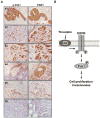Thrombin stimulation of inflammatory breast cancer cells leads to aggressiveness via the EGFR-PAR1-Pak1 pathway
- PMID: 23280128
- PMCID: PMC3671940
- DOI: 10.5301/JBM.2012.10437
Thrombin stimulation of inflammatory breast cancer cells leads to aggressiveness via the EGFR-PAR1-Pak1 pathway
Abstract
Inflammatory breast cancer (IBC) accounts for a small fraction but aggressive form of epithelial breast cancer. Although the role of thrombin in cancer is beginning to be unfolded, its impact on the biology of IBC remains unknown. The purpose of this study was to establish the role of thrombin on the invasiveness of IBC cells. The IBC SUM149 cell line was treated with thrombin in the absence or presence of the epidermal growth factor receptor (EGFR) inhibitor erlotinib and protease-activated receptor 1 (PAR1) inhibitor. The effects of pharmacological inhibitors on the ability of thrombin to stimulate the growth rate and invasiveness were examined. We found that the inhibition of putative cellular targets of thrombin action suppresses both the growth and invasiveness of SUM149 cells in a concentration-dependent manner. In addition, thrombin-mediated increased invasion of SUM149 cells was routed through EGFR phosphorylation, and in turn, stimulation of the p21-activated kinase (Pak1) activity in a EGFR-sensitive manner. Interestingly, thrombin-mediated activation of the Pak1 pathway stimulation was blocked by erlotinib and PAR1 inhibitor. For proof-of-principle studies, we found immunohistochemical evidence of Pak1 activation as well as expression of PAR1 in IBC. Thrombin utilizes EGFR to relay signals promoting SUM149 cell growth and invasion via the Pak1 pathway. The study provides the rationale for future therapeutic approaches in mitigating the invasive nature of IBC by targeting Pak1 and/or EGFR.
Figures






References
-
- Even-Ram S, Uziely B, Cohen P, Grisaru-Granovsky S, Maoz M, Ginzburg Y, et al. Thrombin receptor overexpression in malignant and physiological invasion processes. Nat Med. 1998;4:909–14. - PubMed
-
- Nierodzik ML, Karpatkin S. Thrombin induces tumor growth, metastasis, and angiogenesis: Evidence for a thrombin-regulated dormant tumor phenotype. Cancer Cell. 2006;10:355–62. - PubMed
-
- Snyder KM, Kessler CM. The pivotal role of thrombin in cancer biology and tumorigenesis. Semin Thromb Hemost. 2008;34:734–41. - PubMed
-
- Sportès C, Steinberg SM, Liewehr DJ, Gea-Banacloche J, Danforth DN, Avila DN, et al. Strategies to improve long-term outcome in stage IIIB inflammatory breast cancer: multimodality treatment including dose-intensive induction and high-dose chemotherapy. Biol Blood Marrow Transplant. 2009;15:963–70. - PMC - PubMed
Publication types
MeSH terms
Substances
Grants and funding
LinkOut - more resources
Full Text Sources
Medical
Research Materials
Miscellaneous

